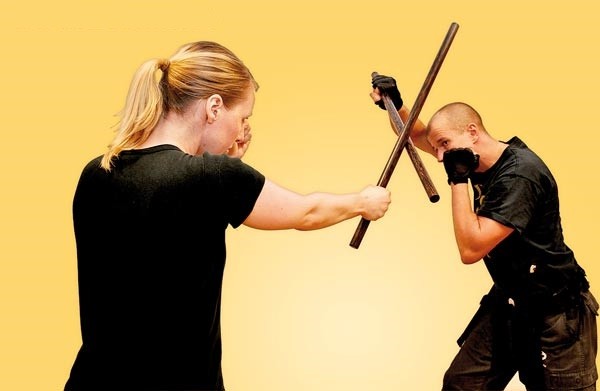Compared to popular martial arts such as Karate, Kung Fu or Krav Maga, the Filipino styles are still pretty much unknown in Europe. This is actually surprising because Eskrima, Arnis and Kali offer an exciting combination of effective self-defense and traditional martial arts. A brief introduction to this fascinating style.
Martial Arts in the Philippines - a long tradition
The Philippines are an archipelago with over 7,100 islands in Southeast Asia. Since prehistoric times, the region has been inhabited by a large number of rival tribes. The indigenous inhabitants developed complex martial arts, mainly using machetes and swords. The conqueror Ferdinand Magellan was defeated by a local tribal leader, Lapu-Lapu, who mastered the art of fighting. Magallan died in 1521 on the island of Mactan. For the Filipinos however, victory lasted only briefly. In the 16th century the islands were colonized by the Spanish Crown.
This also had an effect on traditional combat styles. Some tribes fought on the side of the conquerors and were trained in Spanish fencing. This had a lasting impact on their martial arts. But the European rulers began to fear their subjects after they had consolidated their power. In 1764 colonial power imposed a ban on all martial arts. From then on, tthe arts were practiced in secret. The masters hid some of the techniques in traditional dances and passed them on to the next generations.
Eskrima, Arnis and Kali are modern combat systems
The Philippine martial arts have their roots in the combat fencing of the ancient tribes. In their modern form they emerged only after the end of the Spanish colonial rule in the 20th century. Today the focus is on stick and knife. However, traditional sword fighting techniques continue to be practiced. The Filipino Martial Arts are the official national sport since 2010. Martial arts are taught in all schools in the Philippines. The best athletes compete at the annual Philippine National Games.
There is a wide variety of local styles. The names of the martial arts also differ, as practically every region of the Philippines speaks their own language. Usually, they are summarized with an umbrella term. In the north of the archipelago, in the capitol region around Manila, for example, people usually speak of Arnis. At the center around the island of Cebu, Eskrima or Escrima are more common. Southern regions mostly call it Kali. Rarer to find are other names such as Estoque or Fraile.
And what if I do not have a stick on me?
Also in other Asian regions, there are martial arts which use weapons, i.g. in Japan or China. There too, advanced scholars use sticks and knives. The characteristic of the Philippine styles is, however, that the stick comes first in the curriculum. Later on, the student learns to use the same techniques without weapons. The fighting techniques can be transferred, that’s an important feature of Eskrima, Arnis and Kali. Therefore, it is not difficult for experienced stick fighters to defend themselves completely unarmed or with everyday items.
The techniques are usually called by numbers during training. This makes it easier for beginners, because they don't need to learn too many Filipino names. Motion sequences are learned in the form of drills. Drills are short sequences of individual techniques that improve speed and response by repetition. Important examples are the drills called Sinawali, which are performed in training with a partner, two sticks per person. Eskrima, Arnis and Kali also contain throws and lockings with which the opponent can be brought to the ground.
Filipino Martial Arts - much more than stick fighting
Beginners can chose between various styles. Some are more oriented towards modern self-defense, while others focus on traditions. Getting started is easy because the techniques are based on natural movements. But be warned: Once you have fallen in love with Eskrima, Arnis and Kali, you will not be able to get away from it. There is a virtually unconceivable number of techniques and variants to discover. The martial arts are just as diverse and fascinating as the island kingdom that has produced them.
Did you like this article? Follow Fightingsticks on Facebook and Pinterest.
Photo: © eskrima.se


Errors
Hi there,
Just to let you know, there are some grammatical and spelling errors. You may want you double check. They’re relatively minor. But I’d like to see this reach a lot of people, as a practitioner in the FMA. I would like to share. But I’m a bit of a stickler when it comes to how evens blog is written. Also, if you have an email address, I’d like to send you a couple of things I’ve gathered, regarding the FMA. I would like to see this blog be even better for first timers, or those who are unfamiliar. Because, honestly, I understand this was for beginners, but it’s a little lacking in substance. I apologize if you find this insulting, as I do not intend it to be. Again, I would like to help,by sending what I have, with hopes that you can revise, elaborate, and improve it. Thank you for your 7nderstanding.
Best regards,
Maya’s Na Guro Royce
www.nomadkacf.com
Completely Agree
I've trained in Kali, Jeet Kune Do, and Brazilian Jiujitsu for 15+ years. Of all of those arts, Kali is the one that I love most and have the strongest connection to.
Love it
Thank you so much for writing this article in my own humble opinion the article is vibrant and honest, it explains the names that are used within the 3 major regions which are Luzon, Visayas and Mindanao. I'm 46 years of age and I've been practicing FMA for over 25 years learning the art at such a young age in Subic bay area and now in Australia and teaching this art to my own students including my own 8 years son. This martial arts as given me so much that no amount of money can not buy.